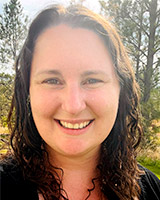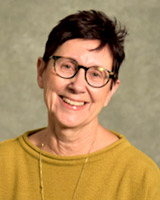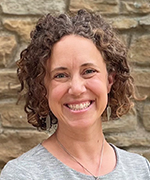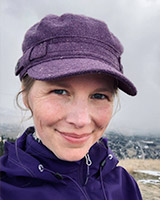Oct 02, 2024
Improving Care and Accessibility for Rural Patients with Disabilities
by Allee Mead
Lewis and Clark Public Health (LCPH), located in rural Helena, Montana, received a grant from the National Association of Chronic Disease Directors (NACDD) to work on policy, systems, and environmental changes that would better serve community members with disabilities.
LCPH asked Ability Montana, a Center for Independent Living, to look at the department's forms and website and the public health building's physical environment to identify accessibility issues. This process is called a walk audit, in which people with disabilities go through a building and point out aspects that are inaccessible or difficult to work.

Sarah Sandau, the Community Health Promotion Administrator for LCPH, said there was a difference between what she thought LCPH would need to fix and what issues were actually identified.
"Our building is old, and a lot of the changes we made were door-related," she said. "How long do the automatic doors open for? How heavy are they when they open? The emergency button outside of the wheelchair-accessible exit for emergencies was also too high to reach. To get to the elevator, you had to badge in, but then there was no automatic door to open it."
"Rural residents with disabilities face the same barriers to accessing healthcare that all rural residents face," Dr. Carrie Henning-Smith, Co-Director of the University of Minnesota Rural Health Research Center, said. "But on top of that, rural residents with disabilities have compounded barriers to care."
Experts across the country discuss these barriers to care as well as ways health professionals can improve care for patients with disabilities, including walk audits, training, and partnerships with community organizations.
Accessibility issues
In addition to issues with automatic doors or emergency buttons, rural healthcare facilities may not have accessible medical equipment. "Having the right equipment…requires a lot of capital investment from healthcare facilities and systems," Henning-Smith said.

"Even in metropolitan areas, it's very difficult for women who use a wheelchair to get a mammogram," Dr. Rebecca Kronk, who previously served as president of Alliance for Disability in Health Care Education, Inc. (ADHCE), said. "Very few areas have equipment that's accessible."
Henning-Smith said healthcare facilities should also "think about the height of the exam table, think about the chairs available in an exam room, think about whether someone who might be using a wheelchair or other device could easily navigate different parts of a healthcare facility." Facilities should also consider making the "noises and lights and colors appropriate and welcoming for people who might be neurodivergent."
While Ability Montana also identified issues that LCPH did not have the funding or ability to fix at that time, they "were able to make some changes that were easy and possible and instantly made a difference," Sandau said.

"It's important for you to experience a walk audit because you'll discover concerns you never imagined. Your takeaway is a lot bigger than 'This sidewalk doesn't have a curb cut,'" Sandau said.
"A walk audit teaches us how to listen to people with lived experience and brings up questions we didn't know to ask," Sandau said, "questions like: How do we hear other people's perspectives, how do we open our minds, and how can accessibility be improved for our clients and partners?"
Physician biases and health professional training
Dr. Megan Henly is the director of the New Hampshire Disability and Health Program, a public health program funded by the Centers for Disease Control and Prevention (CDC). Henly said that 10 states have this CDC funding for disability and health programs, and New Hampshire collaborates with the other nine states. Priorities for these programs include promoting health interventions for adults with disabilities; connecting them to resources for preventive care, such as New Hampshire's Health Linkage Program; and disseminating disability competency training to healthcare providers.

"Many people, including healthcare providers, may think that poor health is a byproduct of the disability itself, but people with disabilities can engage in healthy practices and they can be healthy," Henly said. "What tends to be a barrier to good health is things like social determinants of health, things like access to healthcare. And that means both physical environmental access and structural access, but also things like physician biases."
Many people, including healthcare providers, may think that poor health is a byproduct of the disability itself, but people with disabilities can engage in healthy practices and they can be healthy.
A 2021 Health Affairs article found that 82.4% of 714 physicians surveyed believed that patients with significant disabilities had worse quality of life than nondisabled patients, and only 40.7% felt "very confident" about providing the same quality of care to patients with disabilities.
To address biases and improve confidence and skills around providing care to people with disabilities, the New Hampshire Disability and Health Program offers a health professional training on Responsive Practice. This free training is available for a variety of health professionals, including physicians, nurses, dentists, social workers, administrative staff, and community health workers. The training has two modules: a one-hour module on treating and screening patients with disabilities and a half-hour module on communicating with patients with disabilities.
Videos in the training discuss health disparities and barriers for people with disabilities and offer some vignettes of effective and ineffective ways to communicate with patients. Henly said the training has been promoted by the other CDC-funded state programs since 2022.
Henly said over 2,000 healthcare providers across the country have completed the training. The New Hampshire Disability and Health Program is also working with nursing programs across the state so that nursing students can receive this training. Henly said she has heard back from faculty members who have used the training: "They tell us they like the format and how the concepts can be broadly applicable to all patients."
Communicating with patients
For example, using plain language can help patients with disabilities as well as patients with lower literacy or whose first language is not English. Talking to the patient instead of only to a family member or caregiver may also help a teenage patient or an older patient feel respected and not infantilized.
Kronk from ADHCE learned from a person with a spinal injury that he stopped bringing his wife to his medical appointments because his healthcare providers talked to her instead of to him. In addition, it's important "to communicate in whatever capacity that the patient can communicate," she said. "Sometimes, you need different technologies to support that."
Kronk said it's also important to screen patients for abuse (and to have the conversation away from the caregiver, if one is at the appointment) and to ask about food security and other social determinants of health.
What brought you here today? What is really important to you? And when you leave here today, what would be important for you to have addressed?
"Having insight into their life so that we can give appropriate recommendations that they're agreeable to is so important," Kronk said. She remembered a mentor of hers who would always ask, "What brought you here today? What is really important to you? And when you leave here today, what would be important for you to have addressed?"
Communication and Treatment Resources
- National Roadmap for Disability-Inclusive Healthcare: a plan for clinicians treating people with intellectual and/or developmental disabilities
- Do's and Don'ts When Interacting with a Person who is Blind
- Telehealth Guidance and Resources: Communication Access for Deaf, Hard of Hearing and DeafBlind Patients and their Providers
Practicing humility

"One of the most important things any provider can do is to not make assumptions about anyone who comes in their door," Henning-Smith from Minnesota said. She added, "If they are prescribing some treatment or recommending some service, they should think about the accessibility of that treatment, think about the implications of that in the home and community setting. Is it feasible for people based on their disability status?"
Henning-Smith also advised against expecting patients to educate you on their disabilities but said providers should be "open to listening if the patients are willing and able to share about what some of their challenges are," recognizing that providers often don't have much time with their patients.

…it's not possible to know everything about every type of disability and how disability intersects with other dimensions of identity. But it is important to act with humility and to try to understand and learn as much as you can.
Henning-Smith said it's important to have humility while learning about disability. "It is not possible to know what it's like to live with every type of disability. It's not possible to know someone else's lived experience. And it's not possible to know everything about every type of disability and how disability intersects with other dimensions of identity," she said. "But it is important to act with humility and to try to understand and learn as much as you can."
An open mind and a willingness to listen are necessary for inclusion and accessibility, according to Sandau from Montana: "It was key for us to be ready and open and then really rely on our experts to help guide us, ask the questions, challenge us."
Transportation barriers
Kronk from ADHCE said it's important for healthcare staff to remember how much work it might take someone with a disability to get ready for and travel to an appointment.

Rural residents may not be able to access public transportation in their communities. If public transportation is available, fixed-route service is required to be accessible, but interviews conducted by Research & Training Center on Disability in Rural Communities (RTC:Rural) project directors Krys Standley and Andrew Myers at the University of Montana Rural Institute nonetheless identified real-life barriers in rural areas.
Some of the 33 interviewees said that paratransit rides have to be scheduled in advance and then sometimes the driver cancels the ride, causing a patient to miss a doctor's appointment. Some people who were interviewed said that a bus that is supposed to be wheelchair-accessible may be broken or the driver may not be willing to take the time to secure someone's wheelchair.
Having healthcare providers be flexible with those things and not penalize people is important.
"In effect, the transportation was inaccessible even though it was built to be accessible," Standley said. In other cases, the available transportation may run for limited hours, and someone has an appointment scheduled outside those hours. "Having healthcare providers be flexible with those things and not penalize people is important," she said.
If specialty or other care is not available in a rural community, patients with disabilities may have to travel to urban areas. Kronk recalled working in an urban hospital and having rural patients come in for care. After driving long hours and dealing with the expense of gas and parking, she said that "they were so frazzled" by the time their appointment started. And if the patients have a poor experience at the appointment itself, they may not want to return for follow-up care.
"And then sometimes we get frustrated because they're 10 minutes late," Kronk said. "But there is so much more that happened behind the scenes, and it's so important for healthcare providers to take into account that it wasn't as easy as jump in the car, park, and run into work."

Myers recommended screening patients for transportation issues: "It would be great if providers could ask patients, 'How did you get here and how do you expect to get home?'" He added that patients might have to wait outside for hours for their ride, sometimes in inclement weather.
Sufficient parking outside healthcare facilities is important too, Standley said, along with enough space on either side of an accessible parking space for someone in a wheelchair to have enough room to enter and exit a ramp van.
"People want to show up to their appointments," Myers said.
Partnering with community organizations and stakeholders
Sandau from Montana recommended that healthcare facilities and other organizations looking to improve accessibility should reach out to a Center for Independent Living. "That should be always your first step," she said. "Whether or not they can take a lead, they can at least help connect you, give you ideas, give you resources."
"Ability Montana are our key partners to work with, because they have lived experience. They're working with clients who have lived experience," Sandau said. "They know the ins and outs better than I ever would or ever could." She said LCPH is careful to make sure that any requests they make of Ability Montana align with the center's goals, and LCPH is considerate of the center's time.
Ability Montana also helped LCPH with the amount of new employee training and continuing education needed with regard to accessibility. Sandau said this policy was created four or five years ago and continues to evolve.

Henly from New Hampshire recommended healthcare facilities and organizations see whether their advisory boards include people with disabilities and discuss program decisions with a wide range of stakeholders.
"You're not going to gain trust among your partners if you're just coming in thinking you know everything because the truth is they know their community better than anyone," Myers from Montana said.
Henning-Smith from Minnesota said that providers should learn about and connect with community partners, such as Aging and Disability Resource Centers, to troubleshoot access barriers or social determinants of health like transportation and housing. Other potential partners, according to Henning-Smith, include "community service agencies, aging services, faith-based organizations, and others meeting the needs of those in their community."
"We know that healthcare providers want to be able to serve everyone in their community, and they really just need a better understanding of what disability is, what it means to be healthy with a disability, and how to address that knowledge gap that we're seeing here," Henly said.

